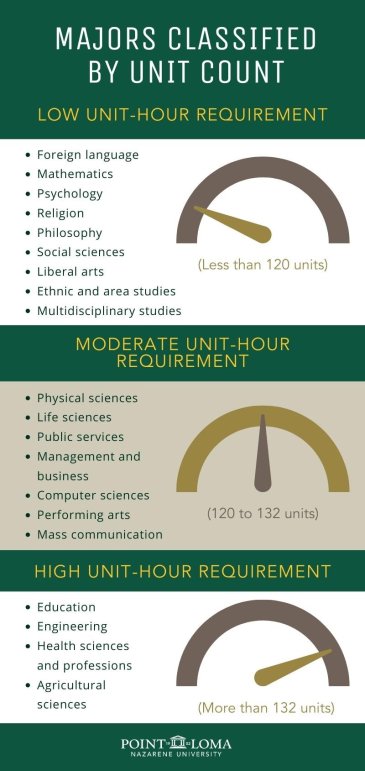
If you’re looking to pursue a degree in higher education, an important factor to consider is the number of units you need to graduate.
In 2021, 4.43 million students graduated from college: 24.6% received an associate’s degree, 49.9% a bachelor’s, 20.8% a master’s, and 4.7% a doctorate or professional degree. Although their degrees varied in level, duration, and field of study, each of them had to keep track of the units needed to graduate.
What are college units?
For students
College units (or credits) measure the duration, rigor, and completion of a course. At most institutions, college courses range from one to five units; however, most are worth three or four.
According to the US Department of Education, a college unit hour “reasonably approximates” one hour of classroom learning and at least two hours of out-of-class student work. For example, if you’re enrolled in a two-unit course, you can expect to spend around two hours in the classroom and four hours doing homework or studying each week.
For institutions
College credits are an essential component of accreditation, which is the certification that US colleges and universities receive when they yield quality education. The number of unit hours a course is worth will help clarify the type of education you’ll earn. This can help make it easier when transferring credits from one accredited institution to another.
Required units to graduate
The number of units that you need to graduate college can vary, as it depends on a couple of factors, including:
- Whether you have transferable units from a previous academic program
- Whether you’re a part-time or full-time student
- Type of degree you’re pursuing
- Type of program and institution you’re enrolled in
Transferring units
From high school
In high school, college units are often not discussed unless you’re enrolled in Advanced Placement (AP), International Baccalaureate (IB), or dual enrollment courses. These courses offer the opportunity to earn college credits before attending an institution of higher education.
From other colleges
Many students start at community colleges and finish their four-year degrees by transferring. Since community colleges are public institutions, they often have agreements with other public institutions within the same state about unit transfers.
PLNU has established partnerships with a number of regional community colleges so students attending classes at these schools can receive the same quality of courses that they would on the residential campus in Point Loma.
The transfer of units earned at community college or in dual enrollment courses should be granted by the same institution. However, some schools don’t accept dual-enrollment college units, yet will accept units from the same community college if they were earned after high school. Oftentimes, the transferable courses taken at community college can fulfill a university’s general education (GE) requirements.
If you intend on transferring from a community college to a four-year school, make sure to check with your university’s admissions office to make sure the courses you’re taking will transfer without an issue.
__________
Become who you are called to be
Pursue your purpose at PLNU.
__________
Full-time vs part-time student
When enrolling in an accredited institution, you will either be considered a full-time or part-time student. This is determined by the number of credits that you are enrolled in. Typically, students are considered full-time if they take at least 12 units each semester.
Below is the enrollment status breakdown for students enrolled at PLNU.
| Enrollment Status | Full time | 3/4 time | 1/2 time | Less than 1/2 time |
|---|---|---|---|---|
| Number of Units | 12+ | 9-11 | 6-8 | Fewer than 6 |
Type of degree, program, and institution
The type of degree you’re pursuing and the program and institution you’re enrolled in impact the number of units required to graduate.
Below is a breakdown of the average amount of units necessary to graduate with an:
- Associate’s degree
- Bachelor’s degree
- Master’s degree
Associate’s degree
An associate’s degree is a two-year degree that community colleges, junior colleges, and technical schools primarily offer. These programs often cost less than a traditional four-year degree. It also helps transfer students complete their GE requirements before completing their bachelor’s at a traditional undergrad program.
Since an associate’s degree takes fewer years to obtain than a bachelor’s, it also requires fewer units. According to Complete College America, most associate programs require around 65 credits or higher, with 15% of programs requiring just 60 credits.
Bachelor’s degree
To earn a bachelor’s or four-year degree at a university that’s on the semester system, you’ll generally need to complete at least 120 unit hours. If you go to a university that’s on the quarter system, you’ll generally need 180. This is because a quarter unit is approximately two-thirds of a semester unit, as there are 10 weeks in a quarter and 15–16 weeks in a semester.
In addition, most colleges and universities require you to complete credit requirements, such as:
- General education requirements
- Major requirements
- Electives
General education requirements
You’ll typically take GE courses for the first two years of your Bachelor’s degree. The purpose of general education courses is to provide students with a diverse, well-rounded education in various disciplines.
According to Coursera.org, up to half of the unit hours required to graduate will go toward your institution’s general education requirements. Although each institution approaches these core curriculum courses differently, you can expect to take required courses in:
- Humanities
- Math
- Science
- Writing
Major requirements
Some colleges and universities don’t require students to declare a major before starting their undergraduate studies. If this is the case for you, expect to make that decision by the end of your sophomore year.
Once declaring your major, you’ll start to take classes in the subject you’ve chosen. Depending on the department, the required courses for your major can amount to one-third to one-half of your credit hours.
In a Complete College America survey conducted in 2011, all majors in the U.S. were classified according to the number of units required to complete them. They were classified as either a low, moderate, or high unit-hour requirement.

Electives
For any remaining unit requirements, students will take elective courses. These classes provide the opportunity to learn about different subjects. Most degree programs limit the number of electives you can take. This is to help you graduate on time and to focus on your major requirements.
Minors and double majors
The number of units you’ll have to take will not increase if you add a minor. However, this is not always the case when double majoring. If you select majors that are in different departments or schools, such as physics and writing, your major requirements will likely not overlap. At some schools, this may result in an additional semester of classes.
Picking two majors within the same department or school can decrease your chances of having to take more credits because the major requirements may overlap. For example, a student who double majors in electrical engineering and engineering mechanics will likely have to take similar lower-division courses for each discipline. Most universities, but not all, allow for one course to count toward fulfilling two different majors.
Master’s degree
A Master’s degree is an advanced degree that you can earn in a field of interest after your Bachelor’s. The requirements can range from 24 to 60 unit hours for most master’s degree programs.
Some graduate programs, such as ones dedicated to health or teaching fields, have practicum or clinical requirements that may increase the number of unit hours required.
What hinders earning my degree on time?
Yes, there are opportunities offered to help students graduate in less than four years. However, some factors can hinder them from doing so, or even graduating in four years. These factors include:
- Taking uncredited courses outside of the college or university’s premises
- Failing or dropping a course
- Not enrolling in required courses
- Not taking enough courses in a semester or quarter
How many units should I take?
While you typically have the option to take the number of classes that work best for your schedule, keep in mind that taking 12 credits a semester will classify you as a full-time student. If you plan to graduate in two years with an Associate’s or Master’s degree, or four years with a Bachelor’s degree, many colleges and universities recommend you take 15 credits a semester.
Completing more than 15 college credits a semester can help you graduate faster. However, many colleges and universities will put a limit on the number of credits a student can take each semester. If a student chooses to take more than what the institution implements, they may have to pay a higher tuition per additional unit.
Take your next steps at PLNU
About ¼ of new students each year are transfer students at PLNU. If you’re interested in joining our beachfront community, check this webpage for more information.